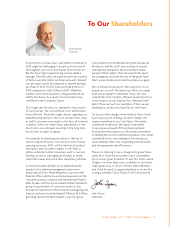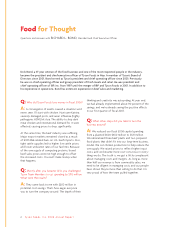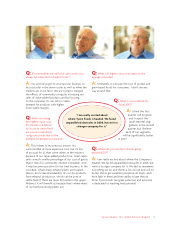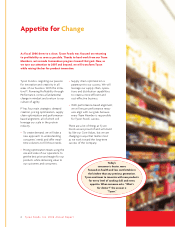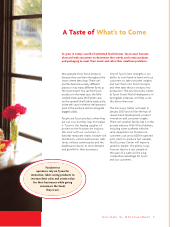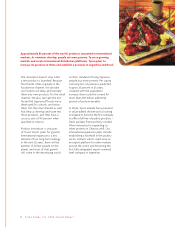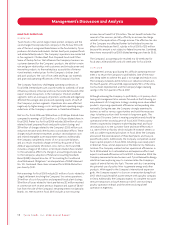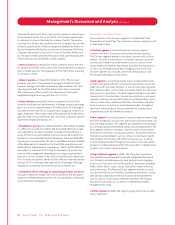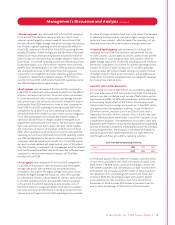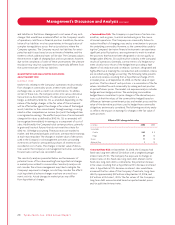Tyson Foods 2006 Annual Report Download - page 13
Download and view the complete annual report
Please find page 13 of the 2006 Tyson Foods annual report below. You can navigate through the pages in the report by either clicking on the pages listed below, or by using the keyword search tool below to find specific information within the annual report.
The Company expects operating margin improvements in each
segment in fiscal 2007. Although the Company’s Chicken segment
will be affected negatively by higher grain prices in fiscal 2007
compared to fiscal 2006, the Company’s mix of value-added prod-
ucts and expected price increases should supply some insulation.
The Company expects live cattle supplies and live hog supplies to
increase in fiscal 2007, which should allow the Company to achieve
greater operational efficiencies in its processing plants. Additionally,
the Company anticipates improved market share in the Prepared
Foods segment in fiscal 2007.
Based on the Company’s outlook for fiscal 2007, diluted earnings
per share are estimated to be in the range of $0.50 to $0.80, and
sales are estimated to be in the range of $26 billion to $27 billion.
The Company expects to reduce its capital spending from the
$531 million spent in fiscal 2006 to approximately $400 million
in fiscal 2007. Additionally, the Company anticipates stronger
cash flow and lower interest expense in fiscal 2007 and plans
to use the improved cash flow to reduce its debt position.
2006 VS. 2005
Certain reclassifications have been made to prior periods to conform
to current presentations.
• Sales decreased $455 million or 1.7%, with a 3.9% decrease in
average sales price and a 2.3% increase in volume. The oversupply
of proteins led to decreased average sales prices in all segments.
Additionally, fiscal 2006 sales were affected negatively by realized
and unrealized net losses of $5 million, compared to realized and
unrealized net gains of $24 million recorded in fiscal 2005 from
the Company’s commodity risk management activities related
to its fixed forward boxed beef and pork sales.
• Cost of Sales increased $337 million or 1.4%. As a percent of sales,
cost of sales increased from 93.4% to 96.4%. The increase in cost of
sales as a percentage of sales primarily was due to the decrease in
average sales prices, while average live prices and production costs
did not decrease at the same rate. Energy costs increased in all seg-
ments by approximately $167 million compared to the same period
last year. Additionally, fiscal 2006 includes $49 million of realized
and unrealized net losses related to the Company’s forward futures
contracts for live cattle and hog purchases, compared to $33 mil-
lion of realized and unrealized net gains recorded in fiscal 2005.
Cost of sales was impacted positively by realized and unrealized
net gains of $6 million in fiscal 2006 resulting from the Company’s
commodity risk management activities related to grain purchases
compared to realized and unrealized net losses of $27 million in
fiscal 2005.
• Selling, general and administrative expenses increased $7 mil-
lion or 0.8%. As a percent of sales, selling, general and administra-
tive expenses increased from 3.6% to 3.7%. The increase primarily was
due to an increase in stock compensation expense, information
system services costs and increased sales promotion expenses. The
increases were offset partially by decreased charitable contributions,
decreased legal and other professional fees and a fiscal 2006 bad
debt recovery. Also, insurance proceeds received in fiscal 2005
decreased prior year costs.
• Other charges include $63 million of plant closing related costs
and $9 million of severance accruals related to the Company’s
$200 million cost reduction initiative. The plant closing costs relate
primarily to closing the Company’s Norfolk and West Point, Nebraska,
and Independence and Oelwein, Iowa, operations. In February 2006,
the Company announced its decision to close its Norfolk, Nebraska,
beef processing plant and its West Point, Nebraska, beef slaughter
plant. These facilities closed in February 2006. Production from
these facilities shifted primarily to the Company’s beef complex
in Dakota City, Nebraska. In January 2006, the Company announced
its decision to close two of its processed meats facilities in northeast
Iowa. The Independenceand Oelwein plants, which produced
chopped ham and sliced luncheon meats, closed in March 2006.
In August 2006, the Company announced its decision to close
its Boise, Idaho, beef slaughter plant and to scale back processing
operations at its Pasco, Washington, complex. This decision resulted
in the elimination of approximately 770 positions. The closure and
process change occurred in October 2006 and did not result in a
significant charge to the Company.
In July 2006, the Company announced its decision to implement
approximately $200 million in cost reductions as part of a strategy
to return to profitability. The cost reductions include staffing costs,
consulting and professional fees, sales and marketing costs and other
expenses. Virtually all of the cost reduction initiatives are expected
to be completed by December 2006, with savings beginning princi-
pally in fiscal 2007.
Other charges in fiscal 2005 include $33 million relating to a legal
settlement involving the Company’s live swine operations and
$14 million in plant closing costs primarily relating to the closings
of the Company’s Cleveland Street Forest, Mississippi; Portland,
Maine; and Bentonville, Arkansas; operations. In July 2005, the
Company announced it had agreed to settle a lawsuit resulting
from the restructuring of its live swine operations. The settlement
resulted in the Company recording an additional $33 million of
costs in the third quarter of fiscal 2005. In July 2005, the Company
announced its decision to make improvements to one of its Forest,
Mississippi, facilities, which included more product lines, enabling
the plant to increase production of processed and marinated chicken.
The improvements were made at the former Choctaw Maid Farms
location, which the Company acquired in fiscal 2003. The Company’s
Ty s on Foods, Inc. 2006 Annual Report11
Management’s Discussion and Analysiscontinued


